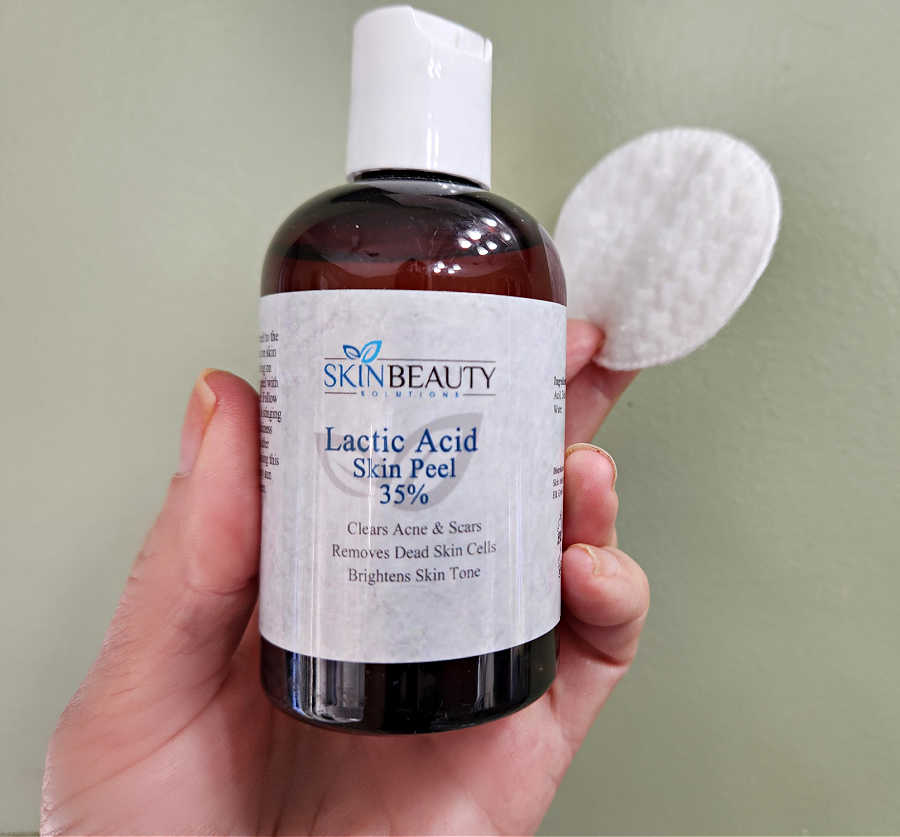As an Amazon Associate, I earn from qualifying purchases and other affiliate links. I only recommend products I’ve tried or researched.
- Home
- Popular Ingredients
- Lactic Acid Peel
Lactic Acid Peel - Why You Should Use It
Mild at-home peels offer instant results for dry, dull, or aging skin. Here's what you need to know for best results.
by: Linda Robison / Facial Fitness Specialist
Afraid to try a lactic acid peel? Don’t be! These gentle, fruit acid based peels can offer quick benefits, especially for skin over 40.

At-home peels are a budget-friendly way to give your skin a radiant glow and a firmer, more youthful appearance. They can also help reduce the look of fine lines, wrinkles, and enlarged pores.
Now, if the term "acid peel" makes you think of a red, irritated, peeling face—don’t worry!
I’ve got some great news for you. Lactic acid peels, which you can buy without a prescription, are not only gentle but also surprisingly hydrating.
In this guide, I’ll walk you through how to choose the right peel, how to use it properly, and what kind of results you can expect.
What is lactic acid
Lactic Acid Definition
Lactic acid is a type of alpha-hydroxy acid (AHA) derived from soured milk or fermented grapes and is considered the least irritating of all the AHA's on the market.
While some AHAs are natural, many skincare products use synthetic versions for better consistency and lower costs.
Side Note: AHAs can be derived from various sources, including fruits, milk, and sugarcane. For natural alternatives, consider trying enzyme-based face masks and visit the Anti-Aging Sugar Scrub page for some great options!
Are lactic acid peels good for your skin?
Yes, they are good for almost all skin types, but are especially helpful to improve the look of aging skin. The mild fruit acid helps dissolve the bond between dead skin cells.
This makes it easier to remove dead, damaged cells from the upper layers of the skin, revealing fresh new cells underneath.
Also, it's hydrating because it helps draw moisture into the skin, which makes it an excellent choice for aging, mature, dry, or sensitive skin.
How often do you need a lactic acid peel?
That depends on several factors:
- The type of peel you're using
- Your individual skin needs
- Your age
In general, it's best to follow the directions on the product label. When I was in my 40s, I used a mild, fruit-based peel about once or twice a week.
This type of lactic acid peel is so gentle that you don’t even need to rinse it off. You can safely use it around delicate areas like under the eyes without any issues. (Check below for more info on this mild fruit-based peel.)
Now that I’m in my 60s, I find that I need something a bit stronger a few times a year to help keep age spots in check and minimize fine lines and wrinkles. The stronger peels also give my skin a beautiful, healthy sheen—not a greasy shine, just a radiant glow.
How do I know when I need to do a peel?
It depends on a few factors, but for me, it’s pretty easy to tell when it’s time. My skin usually starts to:
- Look spotty or uneven
- Lose its natural sheen
- Feel dry, dull or feels bumpy
After a peel, my skin feels incredibly smooth—almost slippery when wet. But when it’s time for another peel, my skin starts to feel rough or bumpy.
Once you’ve tried an acid peel, you’ll know exactly what I mean. You’ll be able to feel the difference and know when it’s time for the next one.
Choose your lactic acid peel
Lactic Acid Products
Basically, you’re looking for a product to deliver a superficial peel at-home. However, lactic acid products vary from 10% to 90% concentration. And, the higher percentage can burn your skin if left on too long!
If you're new to chemical peels, it's best to start off with a mild and easy to use lactic acid product. It does a fantastic job of smoothing your complexion and brightening your skin.
Then after a few months, you can move up the stronger peels as your skin adjusts.
Mild Lactic Acid Peels
Start with a mild lactic acid toner that's fruit based.
If your skin is very sensitive, or you've never used a home chemical peel, look for a mild lactic acid with a 5-10 percent concentration. Anything higher might cause some irritation if you’ve never used a facial peel before.
I’ve been using a fruit acid exfoliant with a 10% concentration and 2.3 pH for years with no side effects and amazing results. It's so mild you don't have to rinse it off, and you can use it around the eyes and lips.
Stronger lactic acid peels
 Lactic acid solution and a cotton pad is all that's needed.
Lactic acid solution and a cotton pad is all that's needed.Stronger lactic acid products for quicker results.
Stronger lactic acid (range from 35% to 90% concentration) products offer significant rejuvenation without the downtime associated with professional skin peels. But, make sure to follow directions carefully.
However, if you don't follow directions exactly, you can risk a mild burn. Most of these peels are only left on the skin for 1-3 minutes and need to be neutralized with a mixture of water and baking soda.
Any downtime after using an at-home peel?
In most brands, there is no downtime and results are usually seen right away. This is not like an in-office chemical peel. Usually, the dead skin (peel) is rinsed away with the solution.
Just make sure to rinse very well!
If you used a concentration that's stronger than your skin is used to, or you left it on too long, you might experience light peeling or slight redness for a day or two after the peel.
But this is rare, if you follow the directions.
What to expect after a lactic acid peel?
If you used a peel appropriate for your skin type and followed the directions, your skin should feel smooth and have a nice glowy appearance.
For some, the skin might feel a bit sensitive or look slight red. This has never happened to me.
Make sure to rinse well, especially in small areas like around the nose, mouth and corners of the eyes. If you miss an area, you might experience a bit of redness, sensitivity and flaking in those areas. This usually goes away in 2-3 days.
Also, make sure to moisturize well and always wear a sunscreen after each treatment. Finally, don't do peels on days you know you'll out in the sun for long periods of time.
Effects of lactic acid
Lactic acid works wonders by improving both the upper and lower layers of your skin. Studies show it can boost firmness, thickness, texture, and smoothness, while also helping to reduce fine lines and wrinkles.
One of the key benefits of lactic acid is that it increases cell turnover. This means it helps "unstick" all those dead skin cells that sit on the surface, making your skin look flaky, dry, and dull.
Why is this so important? Because dead skin cells can settle into fine lines and pores, making them appear larger and deeper. Exfoliating with lactic acid not only clears away those dead cells but also helps stimulate collagen renewal.
Benefits
So, what can you expect from a bi-weekly lactic acid peel? The benefits are pretty impressive, and the best part is you’ll see results almost immediately.
After just one treatment, most people notice an improvement in skin tone, texture, and smoothness. Your skin will have a healthy glow and a bouncy, youthful appearance. Plus, the more you use it, the better the results. I always make sure to use a peel before a special event to get that "extra glow."
Since your skin will be so smooth, your favorite moisturizers or anti-aging creams will absorb better, instead of just sitting on the surface.
The benefits of a mild lactic acid peel include:
- Smaller pores
- Brighter, cleaner skin
- A more even skin tone
- Reduced appearance of fine lines and wrinkles
- Better absorption of skincare products
- Improved hydration
- Bouncier skin texture
Side-effects
For Mild Peels (5-10% Concentration)
With mild peels or fruit acid toners (5-10% concentration), side effects are minimal. Some people with sensitive skin may experience slight tightness or dryness for a few days, but this usually goes away with time.
However, as with any peel, your skin may be more sensitive to the sun for a couple of weeks. Be sure to wear sunscreen daily (which you should be doing anyway!).
For Strong Peels (35%-90% Concentration)
Stronger peels (35%-90% concentration) can cause mild dryness, and you might feel a slight burning sensation around sensitive areas like the lips or nose, especially if you leave it on too long.
Always test a small area first to see how your skin reacts. If you start to feel any burning, rinse off immediately, and next time, try extending the time gradually.
If you're using over-the-counter retinol creams, avoid using lactic acid peels on the same day. Or, do a patch test on a small area to see how your skin reacts. Most over-the-counter retinols are mild, but it's better to be safe.
Personally, I use a retinol booster daily, and after 3-4 months of adjusting, I was able to add a twice-weekly lactic acid peel into my routine without any problems.
If you're using prescription retinoids, other skin medications, or you're under a dermatologist’s care, it's best to check with your doctor before adding a peel to your routine.
Side effects
For Mild Peels (5-10%) Concentration
For the mild (5-10%) concentration peels or fruit acid toners, the side effects are pretty gentle. Some people with sensitive skin might experience slightly tighter or drier skin for a few days. But this usually goes away with over time.
However, as with any peel or exfoliant, your skin could be a bit sensitive to the sun for a few weeks. So it’s best to wear sunscreen (which you should do daily anyway).
Strong Peels (35%-90%) Concentration
With the stronger skin chemical peel (ranging from 35%-90%) - in addition to slight dryness, you may experience mild burning around sensitive areas like lips and nose or if you leave the product on too long.
Again, test a small area and get a feel for how your skin reacts.
If you begin to feel a burning sensation, rinse immediately, and try to extend the time the next time you apply the peel.
Combining lactic acid and OTC retinol creams
Also, if you’re using retinol creams (over-the-counter) every night, skip it on the day you do a peel. Or do a patch test in a small area first to see how your skin will react.
Most over-the-counter retinol creams are relatively mild, but to be on the safe side, test it first.
If you are using a prescription retinoid cream, any skin medications, or are under a dermatologist’s care, check with your doctor first.
Which are better lactic or glycolic acid peels?
When it comes to choosing between glycolic and lactic acid peels, the answer really depends on your skin type and specific needs. Glycolic acid is stronger and often provides more dramatic results, making it a great option for those with combination skin.
On the other hand, lactic acid is milder and better suited for dry or sensitive skin, yet it can still deliver impressive results, especially at higher concentrations.
If you're curious about how these two acids stack up against each other and which one might be best for you, check out my Glycolic vs. Lactic Acid page for a detailed comparison and which products I use.
And if you're interested in maximizing your skincare routine, I also have a page on how to combine glycolic and lactic acid effectively.
This combination can enhance the benefits of both acids and give you the best of both worlds!
Other articles you might like...
Types of At-home Chemical Peels For Hyperpigmentation
About the Author:
Linda Robison is a Facial Fitness Specialist and the founder of Anti-Aging Beauty Zone. With decades of hands-on experience, she shares practical, natural ways to lift and brighten mature skin—without expensive or invasive treatments.
Before you go ....
Please tap on the💙in the bottom right corner if you found this page helpful.
FOLLOW ME FOR MORE TIPS:
SHARE OR SAVE FOR LATER:

